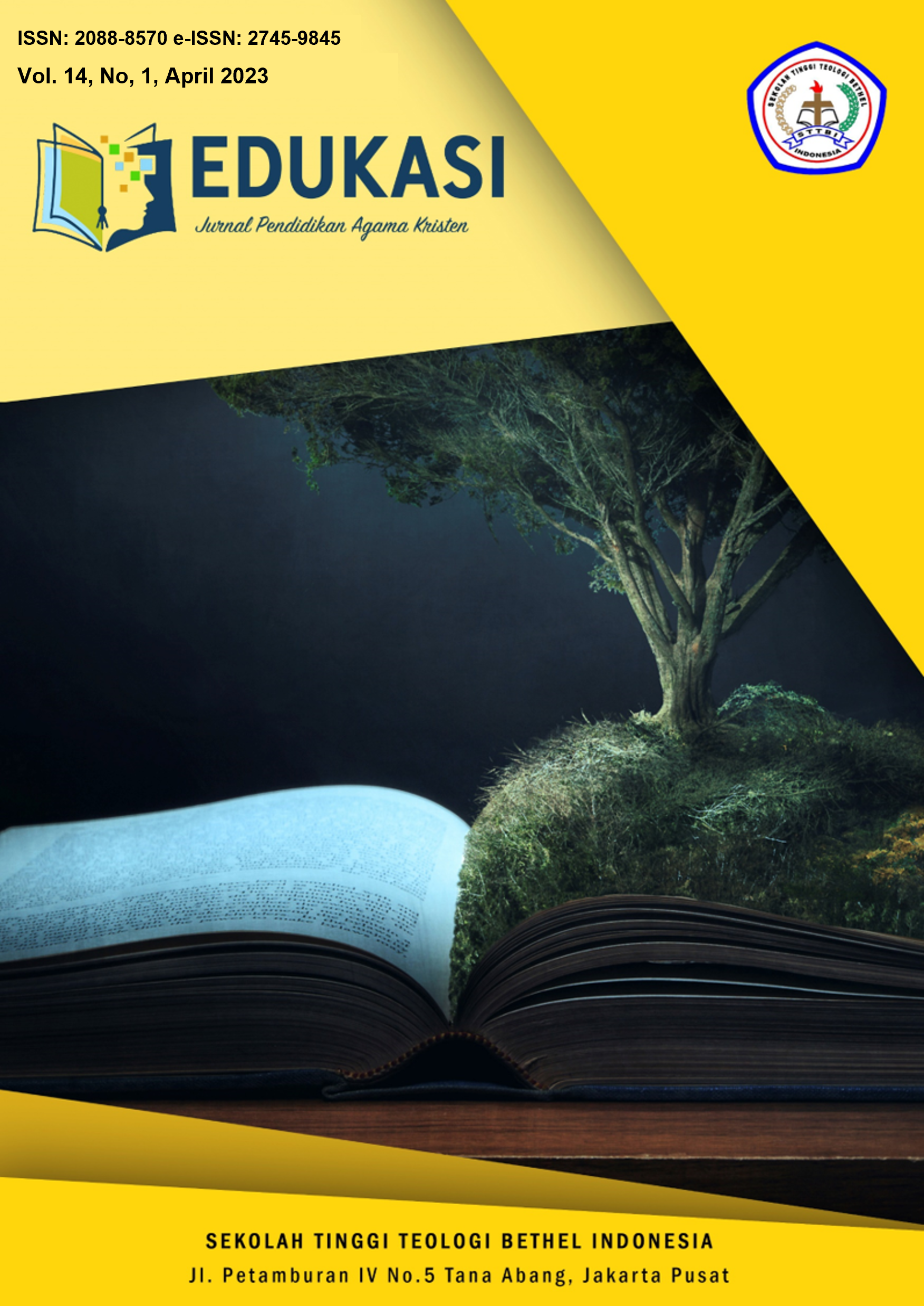RELASI ANTARA TIPE KEPRIBADIAN DAN PERKEMBANGAN KARAKTER MORAL PADA REMAJA
Kata Kunci:
Personality Type, Moral Character, Adolescent(s), Character Education, Qualitative Approach
Abstrak
This study aims to explore the relationship between personality types and the development of moral character among adolescents using a qualitative constructivist approach. Data were collected through literature review and reflective analysis of school documents, then analyzed thematically. The findings reveal that conscientiousness and agreeableness traits positively support the development of moral character such as honesty, responsibility, and empathy, whereas neuroticism tends to hinder moral consistency. Traits of extraversion and openness to experience contribute uniquely by enhancing prosocial behavior and fostering acceptance of broader moral values. The study highlights that the development of adolescents’ moral character results from the interaction between internal factors (personality) and external factors (family, school, and cultural environment). It recommends that character education programs in both schools and families consider personality differences to improve the effectiveness of moral value internalization among adolescents.Referensi
Abbasi-Asl, R., & Hashemi, T. (2019). Personality and morality: Role of the Big Five personality traits in predicting the four components of moral decision making. Personality and Individual Differences, 146, 39–45. https://doi.org/10.1016/j.paid.2019.03.027
Ali, M., & Asrori, M. (2019). Psikologi remaja: Perkembangan peserta didik. Jakarta: Bumi Aksara.
Braun, V., & Clarke, V. (2019). Reflecting on reflexive thematic analysis. Qualitative Research in Sport, Exercise and Health, 11(4), 589–597. https://doi.org/10.1080/2159676X.2019.1628806
Creswell, J. W., & Poth, C. N. (2018). Qualitative inquiry and research design: Choosing among five approaches (4th ed.). Thousand Oaks, CA: SAGE.
Eisenberg, N., Spinrad, T. L., & Knafo-Noam, A. (2015). Prosocial development. In R. M. Lerner (Ed.), Handbook of child psychology and developmental science (7th ed., pp. 610–656). Hoboken, NJ: Wiley.
Harms, P. D., & Credé, M. (2010). Emotional intelligence and transformational and transactional leadership: A meta-analysis. Journal of Leadership & Organizational Studies, 17(1), 5–17. https://doi.org/10.1177/1548051809350894
Hidayati, N. (2021). Pengaruh lingkungan sosial terhadap perkembangan moral remaja. Jurnal Psikologi Pendidikan, 13(2), 101–110.
Kohlberg, L. (1984). Essays on moral development, Vol. 2: The psychology of moral development. San Francisco: Harper & Row.
Lapsley, D. K., & Hill, P. L. (2009). The development of the moral personality. In D. Narvaez & D. K. Lapsley (Eds.), Moral personality, identity, and character: Prospects for a new field (pp. 14–35). New York: Cambridge University Press.
Lincoln, Y. S., & Guba, E. G. (1985). Naturalistic inquiry. Beverly Hills, CA: SAGE.
McCrae, R. R., & Costa, P. T. (2010). The five-factor theory of personality (2nd ed.). New York: Guilford Press.
Narvaez, D., & Lapsley, D. K. (2009). Moral identity, moral functioning, and the development of moral character. In D. Narvaez & D. K. Lapsley (Eds.), Personality, identity, and character: Explorations in moral psychology (pp. 237–274). New York: Cambridge University Press.
Nurhidayah, R. (2020). Faktor-faktor yang mempengaruhi perkembangan moral remaja. Jurnal Pendidikan Karakter, 10(1), 45–56.
Pratiwi, E., & Kurniawan, A. (2021). Pendidikan karakter berbasis tipe kepribadian remaja. Jurnal Psikologi Pendidikan Indonesia, 7(3), 210–218.
Santrock, J. W. (2020). Adolescence (17th ed.). New York: McGraw-Hill Education.
Setiawan, B. (2022). Karakter moral remaja Indonesia dalam perspektif budaya dan agama. Jurnal Sosial dan Humaniora, 14(2), 223–234.
Zhu, Y. (2023). The relationship between personality traits and moral development during adolescence. Journal of Moral Education, 52(1), 45–59. https://doi.org/10.1080/03057240.2022.2147436
Ali, M., & Asrori, M. (2019). Psikologi remaja: Perkembangan peserta didik. Jakarta: Bumi Aksara.
Braun, V., & Clarke, V. (2019). Reflecting on reflexive thematic analysis. Qualitative Research in Sport, Exercise and Health, 11(4), 589–597. https://doi.org/10.1080/2159676X.2019.1628806
Creswell, J. W., & Poth, C. N. (2018). Qualitative inquiry and research design: Choosing among five approaches (4th ed.). Thousand Oaks, CA: SAGE.
Eisenberg, N., Spinrad, T. L., & Knafo-Noam, A. (2015). Prosocial development. In R. M. Lerner (Ed.), Handbook of child psychology and developmental science (7th ed., pp. 610–656). Hoboken, NJ: Wiley.
Harms, P. D., & Credé, M. (2010). Emotional intelligence and transformational and transactional leadership: A meta-analysis. Journal of Leadership & Organizational Studies, 17(1), 5–17. https://doi.org/10.1177/1548051809350894
Hidayati, N. (2021). Pengaruh lingkungan sosial terhadap perkembangan moral remaja. Jurnal Psikologi Pendidikan, 13(2), 101–110.
Kohlberg, L. (1984). Essays on moral development, Vol. 2: The psychology of moral development. San Francisco: Harper & Row.
Lapsley, D. K., & Hill, P. L. (2009). The development of the moral personality. In D. Narvaez & D. K. Lapsley (Eds.), Moral personality, identity, and character: Prospects for a new field (pp. 14–35). New York: Cambridge University Press.
Lincoln, Y. S., & Guba, E. G. (1985). Naturalistic inquiry. Beverly Hills, CA: SAGE.
McCrae, R. R., & Costa, P. T. (2010). The five-factor theory of personality (2nd ed.). New York: Guilford Press.
Narvaez, D., & Lapsley, D. K. (2009). Moral identity, moral functioning, and the development of moral character. In D. Narvaez & D. K. Lapsley (Eds.), Personality, identity, and character: Explorations in moral psychology (pp. 237–274). New York: Cambridge University Press.
Nurhidayah, R. (2020). Faktor-faktor yang mempengaruhi perkembangan moral remaja. Jurnal Pendidikan Karakter, 10(1), 45–56.
Pratiwi, E., & Kurniawan, A. (2021). Pendidikan karakter berbasis tipe kepribadian remaja. Jurnal Psikologi Pendidikan Indonesia, 7(3), 210–218.
Santrock, J. W. (2020). Adolescence (17th ed.). New York: McGraw-Hill Education.
Setiawan, B. (2022). Karakter moral remaja Indonesia dalam perspektif budaya dan agama. Jurnal Sosial dan Humaniora, 14(2), 223–234.
Zhu, Y. (2023). The relationship between personality traits and moral development during adolescence. Journal of Moral Education, 52(1), 45–59. https://doi.org/10.1080/03057240.2022.2147436
Diterbitkan
2023-04-30
Bagian
Articles






